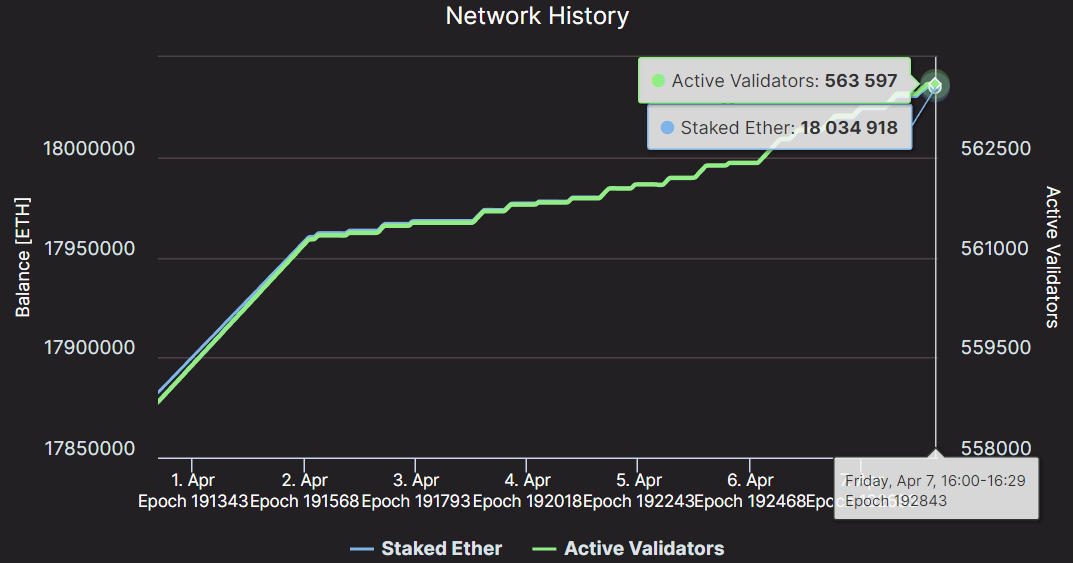In less than a week, on April 12th, Ethereum will finalize its proof-of-work to proof-of-stake transition with the ‘Shanghai’ upgrade. Also dubbed ‘Shapella,’ as it combines Shanghai and Capella improvements, the milestone upgrade is poised to unlock billions worth of ETH.
Ethereum as the First-Mover Chain
Trailing behind Bitcoin, Ethereum has grown into an ecosystem of ecosystems. It may have 41% of Bitcoin’s market cap, but Ethereum has 3x more daily transactions. While Bitcoin is charged with the ‘sound money’ pitch, Ethereum has been rooting itself as DeFi infrastructure. Most importantly, Ethereum’s size now dictates other L1 chains’ development.
To partake in Ethereum’s conglomerate of dApps and L2 scalability networks, it has become a feature to be EVM-compatible. After all, Ethereum holds 63.86% dominance with $40.57 billion in total value locked. It is telling that the next chain by size comes from the world’s largest crypto exchange, Binance Smart Chain (BSC), at only $7.11 billion TVL.

At the present year-to-date rate, Bitcoin still outperforms Ethereum at +68% vs. +55% respectively. However, that may change once the much-awaited Shapella upgrade goes online on April 12th. What does this milestone fork bring to the DeFi table? First, let’s take a look at the road so far.
Ethereum’s Transition: From Beacon Chain to Liquid Staking
In September 2022, Ethereum reduced its energy footprint by ~99%. It did so by ditching miners for validators to secure the network. In other words, capital replaced energy-hungry computing power. However, validators’ stakes become locked for the new proof-of-stake network to remain stable.
As the old proof-of-work chain docked with Beacon Chain, the new Ethereum 2.0 began coordinating validator nodes. Each node uses ETH as collateral to validate transaction blocks, and the more ETH it stakes, the greater the chance for the validator node to be selected and receive Ether rewards.
Presently, Beacon Chain holds over 563,000 validators. They have accumulated a massive 18 million ETH stake, worth around $33.5 billion. Typically, their ETH reward ranges between 4.5% – 5.4% annually.

Having the reputation, size, and advantage of DeFi’s first-mover, betting on Ethereum’s success is exceedingly high, so much so that it spawned an entire liquid staking industry, such as Lido Finance (stETH), Coinbase Wrapped Staked ETH (cbETH) or Rocket Pool (RPL).
Lido alone has $11.15 billion TVL, 57% more than the second largest DeFi chain, BSC. These platforms circumvent locked ETH stakes by serving as intermediaries. For deposited ETH, Lido stakes it and mints stETH in return, wherein ‘st’ denotes staked.
These liquid staking tokens are equal in value to ETH and can be used across lending dApps as collateral for loans.
This liquidity unlock has exploded in popularity and expanded Ethereum’s utility even with validator locks. But that is about to change with the upcoming upgrade on April 12th.
Shanghai and Capella Explained
All proof-of-stake networks have their staking policies. However, one could usually find a lock-up period. This is necessary to ensure validators have a long-term view of the network’s health. Moreover, lock-up periods are useful to stabilize the market as a portion of the cryptocurrency is removed from circulation.
In the case of Ethereum, the psychological lock-up dam will finally be broken with Shapella. Consisting of Shanghai and Capella, this milestone upgrade will make ETH withdrawable periodically and predictably.
Specifically, those stakers who contributed 32 ETH, as the minimum required threshold, will be able to withdraw their ETH, plus the accrued rewards. As the new hard fork is unrolled, it will become a part of the new Ethereum infrastructure. Shanghai alone consists of four Ethereum Improvement Proposals (EIPs):
- EIP-3651 Warm COINBASE – reduction of gas cost for COINBASE (no link to Coinbase the exchange) payments, which are the rewards distributed for adding new Ethereum blocks.
- EIP-3855 PUSH0 instruction – optimization of smart contracts by making them more secure and compact.
- EIP-3860 Limit and meter initcode – fixes a potential DoS attack vector by limiting initcode size. (initcode is the executed code when a new smart contract is created, as the deployed backbone of dApps)
- EIP-4895 Beacon Chain withdrawals – validators can withdraw ETH from Beacon Chain to EVM.
The second part of the Shapella upgrade, Capella, relates to EIP-4895. It makes ETH presently locked on Ethereum’s Execution Layer (EL) to become withdrawable. This is done by unlocking it from Ethereum’s Consensus Layer (CL). Only when Capella is finalized can ETH be credited to an Ethereum address on its EL.
Will Shapella Make Liquid Staking Obsolete?
If anything, we will likely see more flexible staking products after Shapella goes online. After all, Ethereum users can stake, pick the rewards, and re-stake ETH rewards. More innovative staking products are also likely to appear.
For example, staked assets themselves could be tokenized as a derivative token. Then, dApps could launch speculative smart contracts on the future price of staked assets. As is the case in traditional finance, these derivatives could serve as risk hedging.
Additionally, users could be exposed to staking without the actual staking involved. In the meantime, stakers will have to wait for their withdrawal turn. Lido Finance users, in particular, will have to wait for withdrawals to be enabled in May.
For these reasons, likely, we will not see a sudden rush of ETH outflows. However, that also depends on the quality of the transition. If severe glitches pop up, users’ confidence may be shaken, and they may erect selling pressure.
Lastly, it bears keeping in mind that intra-agency turf war is afoot. While the SEC claims that ETH is a security, CFTC is leaning on the side of a commodity. These regulatory agencies are exploiting the legislative void to fill their watchdog coffers. This represents an extra layer of instability not present for the more conservative Bitcoin.
Will you re-stake your withdrawable ETH or gather the profits before the recession sets in? Let us know in the comments below.
 tokenist.com
tokenist.com
